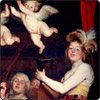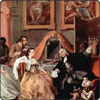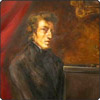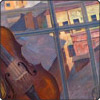One-Click Concerts™
Music History Tour
To celebrate our Grand Opening, we invite all our visitors to enjoy our special four-part series featuring essential pieces of Classical Music, from the 17th century to the present. Each "One-Click Concert™" is about 2 hours long and is devoted to a major period of music history: Baroque, Classical, Romantic and Modern.
The great works in the first three concerts are performed by our wonderful legacy artists whom we salute here, as they are now joined within the new Archives by their eminent brethrens from the labels.
Each program is introduced by some brief commentary to acquaint the newcomer to classical music with some guidelines and important considerations, as they enjoy these musical tours.
 Loading...
Loading...We start with the Baroque era, a large period spanning roughly 1600-1750.
The word "baroque" means "misshapen pearl" which suggests the generally ornate and stylized approach to works of art, architecture, and music during these years. This is the period that saw the birth of opera, as well as the rise of purely instrumental forms such as the concerto and sonata; it is also the period in which modern-day harmony (major and minor keys, modulation, etc.) was developed. Our brief chronological tour begins with the two Venetian pioneers of the early Baroque, Gabrieli and Monterverdi, and proceeds to include a series of works by the most important musical figures of the era - including those three masters all born in 1685: J.S. Bach, Handel, and Domenico Scarlatti.
In this program, moreover, one can see the international character of the Baroque, with composers from Italy, France, and Germany here represented. The program likewise includes examples of the many musical genres that first appeared in the Baroque era: the opera, oratorio, concerto, and sonata – all genres that would continue into our next period, the Classical era.
-
Giulio Romano Caccini Composer
Ave Maria Work
Academy of Choral Arts, Moscow Ensemble -
Girolamo Frescobaldi Composer
Galliarda (unidentified) Work
Alexander Vynograd ArtistGalliarda (arr. guitar)
-
Jean-Baptiste Lully Composer
Venerabilis barba capucinorum, LWV76/xxvi (a3) Work
-
Henry Purcell Composer
The Fairy Queen, Z.629 (semi-opera) Work
Seasons Chamber Orchestra Ensemble1a.First Musick: Prelude
-
1b.First Musick: Hornpipe
-
3.Overture: Grave and Canzona
-
2a.Second Musick: Air
-
2b.Second Musick: Rondeau
-
7a.Prelude
-
26.Third Act Tune: Hornpipe
-
19.Dance for the Fairies
-
60.Chaconne: Dance for Chinese Man and Woman
-
Tomaso Giovanni Albinoni Composer
Concerto a cinque for Oboe, 2 Violins, Viola, Cello, and Continuo in D-, Op.9, No.2, (T.9/2) Work
Malcolm Messiter Artist1.Allegro e non presto
-
2.Adagio
-
3.Allegro
-
Antonio Vivaldi Composer
Concerto for Violin and Cello in Bb, RV547 Work
Moscow Chamber Orchestra ARCO Ensemble -
Johann Sebastian Bach Composer
Viola da gamba Sonata No.1 in G, BWV1027 Work
Kirill Rodin Artist1.Adagio
-
2.Allegro ma non tanto
-
3.Andante: Recitativo
-
4.Allegro moderato
-
George Frideric Handel Composer
Violin Sonata in D, Op.1, No.13, HWV371 Work
Alexei Koshvanets Artist -
Domenico Scarlatti Composer
Sonata in A, K.39, L.391, P.53, F.550, Allegro Work
Dmitry Gordin Artist -
Sonata in A-, K.54, L.241, P.147, F.12, Allegro Work
-
Sonata in B-, K.87, L.33, P.43, F.48 Work
-
Christoph Willibald von Gluck Composer
Paride ed Elena (opera) Work
Oleg Ryabets Artist5.Scene 3: Le belle immagini
-
3.Scene 1: O del mio dolce ardor
Next in our tour is a segment dedicated to the Classical era, the period spanning roughly the years 1730-1800.
The musical designation "classical period" was first coined in the 1830s to refer especially to the "Viennese School" of Mozart and Haydn, but has since been broadened to subsume the entire period between the more heavily-ornate Baroque and the more emotionally-charged Romantic eras; while admittedly simplistic, the term "classical" does suggest the emphasis for orderly, balanced, and natural musical discourse that marks this period.
It is not unrelated that these years correspond to the Enlightenment and the rise of democracy, to which the straightforward and often "popular" approach to musical expression formed a logical counterpart. Our brief chronological tour begins with a set of "transitional" and so-called “pre-Classical” works by Sammartini, Pergolesi, C.P.E. Bach, and Gluck, and then moves into the full-blown Classical era with masterworks by Haydn and Mozart, as well as by the Italians Boccherini, Cherubini, and Salieri.
The concert concludes with an early masterwork of Beethoven (himself a student of Haydn), already suggesting the changes to come in the Romantic era.
-
Giovanni Battista Pergolesi Composer
Stabat mater, for soprano, alto, and strings Work
Oleg Ryabets Artist2.Aria: Cujus animam gementem
-
Giovanni Battista Sammartini Composer
Suite for Violin and Harpsichord Work
Mikhail Utkin Artist2.Arioso
-
Johann Christian Bach Composer
Harpsichord Concerto in Eb, Op.7, No.5 Work
various artists Artist1.Allegro di molto
-
2.Andante
-
3.Allegro
-
Antonio Soler Composer
Concerto for 2 Organs Work
Serge Yuchkevitch Artist1.Andante
-
(Franz) Joseph Haydn Composer
String Quartet No.43 in G, Hob.III:58, Op.54, No.1 Work
Komitas State Quartet Ensemble1.Allegro con brio
-
2.Allegretto
-
3.Menuetto
-
4.Finale: Presto
-
Luigi Boccherini Composer
Cello Concerto in G, G.480 Work
Ivan Monighetti Artist1.Allegro
-
Antonio Salieri Composer
Concerto for Flute and Oboe Work
Alexei Utkin Artist2.Largo e mesto
-
Muzio Clementi Composer
Sonatina in C, Op.36, No.1 ('Progressive Sonatina No.1') Work
Alexander Vynograd Artist -
Ludwig van Beethoven Composer
Cello Sonata in F, Op.5, No.1 Work
Marina Tarasova Artist1.Adagio sostenuto. Allegro
The third segment is dedicated to the Romantic era, the period spanning roughly the duration of the 19th century.
The term "Romanticism" was first applied to trends in literature in the late 18th century, as an idealized revival of the Medieval "romance," and soon spread to its sister arts, painting and music. In each of these, the term embraces a belief in the power of human emotions, and especially in the vital expression of an artist’s innermost "truths" - in defiance of the rule-bound traditions of the preceding age. In music history, the term generally refers to the period between Beethoven’s maturity and the rise of the modernist trends of the early 20th century.
Our brief survey represents several of the most important musical trends of the era: the expansion of form and harmony in the instrumental works of Schubert and Dvořák; the love of the piano miniature, as epitomized in salon favorites of Schumann and Chopin; the fascination with instrumental virtuosity in concertos of Brahms and Grieg; the celebration of national or "folk" identity in a work of Tchaikovsky; the new realism of opera in arias by Bizet and Puccini, and finally the growing mannerism of subjective musical expression, as heard in Mahler’s grand Symphony No.4, that in many ways signaled the exhaustion of the era - and which in turn opened the door to the new trends to come in the Modern era.
-
Franz Peter Schubert Composer
Piano Trio No.2 in Eb, D.929, Op.100 Work
Moscow Trio Ensemble1.Allegro
-
Robert Alexander Schumann Composer
Fantasy in C, Op.17 Work
Yossi Reshef Artist1.Durchaus phantastisch und leidenschaftlich vorzutragen. Im Legendenton. Erstes Tempo
-
Frédéric François Chopin Composer
3 Nocturnes, Op.9 (includes the famous 'Nocturne in Eb') Work
Oleg Boshniakovich ArtistNo.2 in Eb
-
Johannes Brahms Composer
Violin Concerto in D, Op.77 Work
Eduard Grach Artist1.Allegro non troppo
-
Niccolò Paganini Composer
Violin Concerto No.2 in B-, Op.7 ('La campanella') Work
Nadezda Tokareva Artist3.Rondo ('La Campanella')
-
Bedrich Smetana Composer
The Bartered Bride (Prodaná nevesta; opera), JB 1:100 Work
Moscow Symphony Orchestra Ensemble1.Overture
-
Georges Bizet Composer
Carmen (opéra-comique) Work
Svetlana Sidorova De Sanghi Artist11b.L'amour est un oiseau rebelle (Habañera)
-
Giuseppe Verdi Composer
La Traviata (opera) Work
Marina Andreyeva Artist8.È strano!...Ah, fors'è lui; 9.Follie! Delirio vano è questo!...Sempre libera
-
Gustav Mahler Composer
Das Lied von der Erde, for alto (or baritone), tenor and orchestra Work
Svetlana Sidorova De Sanghi Artist2.Der Einsame im Herbst (The Solitary Autumn)
The final program is dedicated to the Modern era, the period spanning from roughly the beginning of the 20th century to the end of World War II. More recent trends are subsumed in the Contemporary Period, which leads to the present day.
No preceding period of art history has witnessed such tremendous stylistic diversity or such a swift rate of change as the first half of the 20th century, a reflection of the rapid societal and technological changes that have transpired during the same period. Music kept up as well as any other art in reflecting the sometimes radical shifts in Western culture from 1900, as our brief survey reveals: at the beginning came an experimental, even multi-cultural, attempt to resolve the harmonic "dilemma" that emerged at the end of the 19th century, as seen in the works of Debussy and Berg; the intense pulse of the modern city found musical reflection in the sometimes jarring rhythms of Stravinsky and Bartók; the drive to study folk or "peasant" music found expression in the works Rodrigo and Shostakovich; and all the while there continued the public and private call for an emotional component in music, as manifested brilliantly in the works of Rachmaninov, Barber, and Britten.
Our tour concludes with a late-Modern work by the French composer Olivier Messiaen, begun while a prisoner of war during World War II. In many ways, the sparse and often complex counterpoint reveals this as a transitional work into the Contemporary era.
-
Achille Claude Debussy Composer
Estampes, L.100 Work
Pavel Gintov Artist1.Pagodes
-
2.La soirée dans Grenade
-
3.Jardins sous la pluie
-
Sergey Vasilyevich Rachmaninoff Composer
Rhapsody on a Theme by Paganini, Op.43 Work
Elisso Bolkvadze ArtistIntroduction: Allegro vivace
-
Var.1: Tempo precedente
-
Tema. L'istesso tempo
-
Var.2: L'istesso tempo
-
Var.3: L'istesso tempo
-
Var.4: Più vivo
-
Var.5: Tempo precedente
-
Var.6: L'istesso tempo
-
Var.7: Meno mosso, a tempo moderato
-
Var.8: Tempo primo
-
Var.9: L'istesso tempo
-
Var.10: Poco marcato
-
Var.11: Moderato
-
Var.12: Tempo di menuetto
-
Var.13: Allegro
-
Var.14: L'istesso tempo
-
Var.15: Più vivo. Scherzando
-
Var.16: Allegretto
-
Var.17: Allegretto
-
Var.18: Andante cantabile
-
Var.19: L'istesso tempo
-
Var.20: Un poco più vivo
-
Var.21: Un poco più vivo
-
Var.22: Un poco più vivo (alla breve)
-
Var.23: L'istesso tempo
-
Var.24: A tempo, un poco meno mosso
-
Béla Bartók Composer
7 Romanian Folk Dances (Román népi táncok), BB76 Work
various artists Artist -
Igor Stravinsky Composer
Petrouchka, 3 movements for piano Work
Maki Sekiya Artist -
Alban Berg Composer
Piano Sonata in B-, Op.1 Work
Roberto Poli Artist -
Sergey Sergeyevich Prokofiev Composer
Toccata in D-, Op.11 Work
Peter Dmitriev Artist -
Robert Moran Composer
Arias and Inventions from "Desert of Roses" Work
various artists Artist -
Efrem Podgaits Composer
The Moon-Pipes (A Fairy Tale Cantata) Work
Vesna Children's Choir Ensemble


















